Absalom
Absalom (Hebrew: אַבְשָׁלוֹם Aḇšālōm, "father of peace"), according to the Hebrew Bible, was the third son of David, King of Israel with Maacah, daughter of Talmai, King of Geshur.[2]
| Absalom | |
|---|---|
| Prince of Israel | |
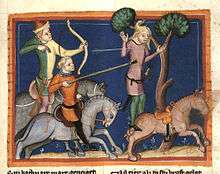 The death of Absalom, hanging from a tree by his hair (14th-century German miniature). | |
| Born | Hebron, Judah, Israel |
| Died | Ephraim's Wood, Israel |
| Burial | Ephraim's Wood, Israel |
| Issue | 5+ children:[1]
|
| House | House of David |
| Father | King David |
| Mother | Maacah bat Talmai |
2 Samuel 14:25 describes him as the most handsome man in the kingdom. Absalom eventually rebelled against his father and was killed during the Battle of Ephraim's Wood.[3]
Biblical account
Background
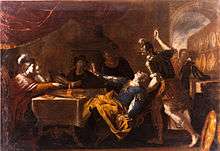
Absalom, David's third son, by Maacah, was born in Hebron.[4] He moved at an early age along with the transfer of the capital to Jerusalem, where he spent most of his life. He was a great favorite of his father, and of the people. His charming manners, personal beauty, insinuating ways, love of pomp, and royal pretensions, captivated the hearts of the people from the beginning. He lived in great style, drove in a magnificent chariot, and had fifty men run before him.
Little is known of Absalom's family life, but the biblical narrative states that he had three sons and one daughter, whose name was Tamar and is described as a beautiful woman.[1] From the language of 2 Samuel 18:18, "I have no son to keep my name in remembrance", it is implied that his sons died at an early age.[5]
Although he had no sons 2 Chronicles 11:20 says that Absalom had another daughter or granddaughter named Maacah, who later became the favorite wife of Rehoboam.[6] Maacah was the mother of Abijah of Judah, and grandmother of Asa of Judah. She served as queen mother for Asa, until he deposed her for idolatry. (1 Kings 15:1-14, 2 Chronicles 11:20-22, 2 Chronicles 15:16)
Murder of Amnon
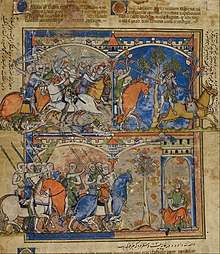
Absalom's sister, who was also called Tamar, was raped by Amnon, who was their half-brother. Amnon was also David's eldest son. After the rape, Absalom waited two years, and then avenged Tamar by sending his servants to murder a drunken Amnon at a feast, to which Absalom had invited all the king's sons (2 Samuel 13).
After this murder Absalom fled to Talmai, who was the king of Geshur and Absalom's maternal grandfather[7] (see also Joshua 12:5 or 13:2). It was not until three years later that Absalom was fully reinstated in his father's favour and finally returned to Jerusalem[8] (see Joab).
The revolt at Hebron
While at Jerusalem, Absalom built support for himself by speaking to those who came to King David for justice, saying, "See, your claims are good and right; but there is no one deputed by the king to hear you", perhaps reflecting flaws in the judicial system of the united monarchy. "If only I were the judge of the land! Then all who had a suit or cause might come to me, and I would give them justice." He made gestures of flattery by kissing those who bowed before him instead of accepting supplication. He "stole the hearts of the people of Israel".[9]
After four years he declared himself king, raised a revolt at Hebron, the former capital, and slept with his father's concubines.[10] All Israel and Judah flocked to him, and David, attended only by the Cherethites and Pelethites and his former bodyguard, which had followed him from Gath, found it expedient to flee. The priests Zadok and Abiathar remained in Jerusalem, and their sons Jonathan and Ahimaaz served as David's spies. Absalom reached the capital and consulted with the renowned Ahithophel (sometimes spelled Achitophel).
David took refuge from Absalom's forces beyond the Jordan River. However, he took the precaution of instructing a servant, Hushai, to infiltrate Absalom's court and subvert it. Hushai convinced Absalom to ignore Ahithophel's advice to attack his father while he was on the run, and instead to prepare his forces for a major attack. This gave David critical time to prepare his own troops for the battle.
Battle of Ephraim's Wood

A fateful battle was fought in the Wood of Ephraim (the name suggests a locality west of the Jordan) and Absalom's army was completely routed.[11] Absalom's head was caught in the boughs of an oak tree as the mule he was riding ran beneath it. He was discovered there still alive by one of David's men, who reported this to Joab, the king's commander. Joab, accustomed to avenging himself, took this opportunity to even the score with Absalom.[12] Absalom had once set Joab's field on fire[13] and then made Amasa Captain of the Host instead of Joab. Killing Absalom was against David's explicit command, "Beware that none touch the young man Absalom". Joab killed Absalom with three darts through the heart.
When David heard that Absalom was killed, although not how he was killed, he greatly sorrowed.
O my son Absalom, my son, my son Absalom! Would God I had died for thee, O Absalom, my son, my son![14]
David withdrew to the city (Mahanaim)[15] in mourning, until Joab roused him from "the extravagance of his grief" [16] and called on him to fulfill his duty to his people.[17]
Memorial
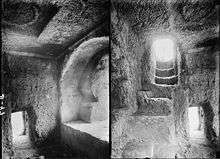
Absalom had erected a monument near Jerusalem to perpetuate his name:[18]
Now Absalom in his lifetime had taken and reared up for himself a pillar, which is in the king's dale: for he said, I have no son to keep my name in remembrance: and he called the pillar after his own name: and it is called unto this day, Absalom's place.
An ancient monument in the Kidron Valley near the Old City of Jerusalem, known as the Tomb of Absalom or Absalom's Pillar and traditionally identified as the monument of the biblical narrative, is now dated by modern archeologists to the first century AD.[19] The Jewish Encyclopedia reports: "A tomb twenty feet high and twenty-four feet square, which late tradition points out as the resting-place of Absalom. It is situated in the eastern part of the valley of Kidron, to the east of Jerusalem. In all probability it is the tomb of Alexander Jannæus (Conder, in Hastings' Dict. Bible, article "Jerusalem", p. 597). It existed in the days of Josephus ("Antiquities" vii. 10, § 3). See illustrations on pp. 133, 134.[20] However, archaeologists have now dated the tomb to the 1st century AD.[21] In a 2013 conference, Professor Gabriel Barkay suggested that it could be the tomb of Herod Agrippa, the grandson of Herod the Great, based in part on the similarity to Herod's newly discovered tomb at Herodium. For centuries, it was the custom among passers-by—Jews, Christians and Muslims—to throw stones at the monument. Residents of Jerusalem would bring their unruly children to the site to teach them what became of a rebellious son.[22]
Rabbinic literature
The life and death of Absalom offered to the rabbis a welcome theme wherewith to warn the people against false ambition, vainglory, and unfilial conduct. The vanity with which he displayed his beautiful hair, the rabbis say, became his snare and his stumbling-block. "By his long hair the Nazirite entangled the people to rebel against his father, and by it he himself became entangled, to fall a victim to his pursuers" (Mishnah Soṭah, i. 8). And again, elsewhere: "By his vile stratagem he deceived and stole three hearts, that of his father, of the elders, and finally of the whole nation of Israel, and for this reason three darts were thrust into his heart to end his treacherous life" (Tosef., Soṭah, iii. 17). More striking is the following: "Did one ever hear of an oak-tree having a heart? And yet in the oak-tree in whose branches Absalom was caught, we read that upon its heart he was held up still alive while the darts were thrust through him [Mek., Shirah, § 6]. This is to show that when a man becomes so heartless as to make war against his own father, nature itself takes on a heart to avenge the deed."
Popular legend states that the eye of Absalom was of immense size, signifying his insatiable greed (Niddah, 24b). Indeed, "hell itself opened beneath him, and David, his father, cried seven times: 'My son! my son!' while bewailing his death, praying at the same time for his redemption from the seventh section of Gehenna, to which he was consigned" (Soṭah, 10b). According to R. Meir (Sanh. 103b), "he has no share in the life to come". And according to the description of Gehenna by Joshua ben Levi, who, like Dante, wandered through hell under the guidance of the angel Duma, Absalom still dwells there, having the rebellious heathen in charge; and when the angels with their fiery rods run also against Absalom to smite him like the rest, a heavenly voice says: "Spare Absalom, the son of David, My servant."[23]
Art and literature
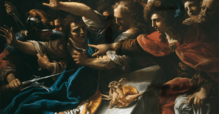
Poetry
- Absalom and Achitophel (1681) is a landmark poetic political satire by John Dryden, using the Biblical story as a metaphor for the politics of the poet's own time.[24]
- "Absalom" by Nathaniel Parker Willis (1806–1867)[25]
- "Absaloms Abfall" by Rainer Maria Rilke ("The Fall of Absalom", trans. Stephen Cohn).[26][27]
- "Absalom" is a section in Muriel Rukeyser's long poem The Book of the Dead (1938), inspired by the biblical text, spoken by a mother who lost three sons to silicosis.[28]
- "Avshalom" by Yona Wallach, published in her first poetry collection Devarim (1966), alludes to the biblical character.[29]
Fiction
- In the 1946 short story "Absalom" by C.L. Moore and Henry Kuttner, the character Absalom is a child prodigy, who does non-consensual brain surgery on his father (a former child prodigy, though not as intelligent as his son) to make the father totally focused on Absalom's success. This relates to the Biblical story of the son usurping his father.[30][31]
- Georg Christian Lehms, Des israelitischen Printzens Absolons und seiner Prinzcessin Schwester Thamar Staats- Lebens- und Helden-Geschichte (The Heroic Life and History of the Israelite Prince Absolom and his Princess Sister Tamar), novel in German published in Nuremberg, 1710.[32]
- Absalom, Absalom! is a novel by William Faulkner, and refers to the return of the main character Thomas Sutpen's son.[33]
- Oh Absalom! was the original title of Howard Spring's novel My Son, My Son!, later adapted for the film of the latter name.[34]
- Cry, the Beloved Country by Alan Paton. Absalom was the name of Stephen Kumalo's son in the novel. Like the Biblical Absalom, Absalom Kumalo was at odds with his father, the two fighting a moral and ethical battle of sorts over the course of some of the novel's most important events. Absalom kills and murders a man, and also meets an untimely death.[35]
- Throughout Robertson Davies's The Manticore a comparison is repeatedly made between the protagonist's problematic relations with his father and those of the Biblical Absalom and King David. Paradoxically, in the modern version, it is the rebellious son who has the first name "David". The book also introduces the term "Absalonism", as a generic term for a son's rebellion against his father.[36]
- Absalom appears as a prominent character in Peter Shaffer's play Yonadab, which portrays Amnon's rape of Tamar and his murder at Absalom's hands.[37]
- A scene in the Swedish writer Frans G. Bengtsson's historical novel "The Long Ships" depicts a 10th Century Christian missionary recounting the story of Absalom's rebellion to the assembled Danish court, including the aging King Harald Bluetooth and his son Sweyn Forkbeard; thereupon, King Harald exclaims "Some people can learn a lesson from this story!", casting a meaningful glance at his son Sweyn—whom the King (rightly) suspects of plotting a rebellion.[38]
- In the novel The Book of Tamar by Nel Havas, the story of Absalom is presented from the viewpoint of his sister. While closely following the main events as related in the Bible, Havas concentrates on the motives behind Absalom's actions, which are more complex than depicted in the scriptures.
Music
- Josquin des Prez composed the motet "Absalon, fili mi" on the occasion of the death of Juan Borgia (Absalon being a further alternative spelling).
- Nicholas Gombert composed the two-part, eight-voice motet "Lugebat David Absalon".
- Heinrich Schütz (1585–1672) composed "Fili mi, Absalon" as part of his Sinfoniae Sacrae, op. 6.
- The single verse, 2 Samuel 18:33, regarding David's grief at the loss of his son ("And the king was much moved, and went up to the chamber over the gate, and wept: and as he went, thus he said, O my son Absalom, my son, my son Absalom! would God I had died for thee, O Absalom, my son, my son!"), is the inspiration for the text of several pieces of choral music, usually entitled When David Heard (such as those by Renaissance composers Thomas Tomkins and Thomas Weelkes, or modern composers Eric Whitacre, Joshua Shank, and Norman Dinerstein). This verse is also used in "David's Lamentation" by William Billings, first published in 1778.
- Leonard Cohen's poem "Prayer for Sunset" compares the setting sun to the raving Absalom, and asks whether another Joab will arrive tomorrow night to kill Absalom again.
- "Absalom, Absalom" is a song on the 1996 Compass CD Making Light of It by singer/songwriter Pierce Pettis, incorporating several elements of the biblical narrative.
- The Australian composer Nigel Butterley set the verse in his 2008 choral work "Beni Avshalom", commissioned by the Sydney Chamber Choir.
- During the finale of the song "Distant Early Warning" by Canadian band Rush, Geddy Lee sings, "Absalom, Absalom, Absalom"; lyrics written by drummer Neil Peart.
- David Olney's 2000 CD Omar's Blues includes the song "Absalom". The song depicts David grieving over the death of his son.
- The story of Absalom is referred to several places in folk singer Adam Arcuragi's song "Always Almost Crying".
- The San Francisco-based band Om mentions Absalom in their song "Kapila's Theme" from their debut album Variations on a Theme.
- The garage folk band David's Doldrums references Absalom in their song, "My Name Is Absalom". The song alludes to Absalom's feelings of solemnity and abandonment of love and hope.
- In "Every Kind Word" by Lackthereof, Danny Seim's project parallel to Menomena, Seim sings "... and your hair is long like Absalom."
- "Barach Hamelech", an Israeli song by Amos Etinger and Yosef Hadar.
- The grindcore band Discordance Axis references Absalom at the end of the track entitled "Castration Rite".
- In 2007 Ryland Angel released "Absalom" on Ryland Angel-Manhattan Records.
- "Hanging By His Hair" from the 1998 Wormwood album by The Residents recounts Absalom's defiance and death. Also performed on Roadworms (The Berlin Sessions) and Wormwood Live.[39]
- "Absalom" is a song on Brand New Shadows's debut album, White Flags. It is a mournful lament from King David's perspective.[40]
- "Absalom" is an album by the experimental/progressive band Stick Men featuring Tony Levin, Markus Reuter and Pat Mastelotto.
- The American Rock band Little Feat reference Absalom in their song "Gimme a Stone" on the album entitled Chinese Work Songs.[41] This song is written from the perspective of King David—mainly focusing on the task of fighting Goliath—but contains a lament to Absalom. This was a cover of the song, the original being on the 1998 Americana concept album Largo, by David Forman and Levon Helm.
As a name
- "Avshalom" (אבשלום) is commonly used as a male first name in contemporary Israel. Other variants, used either as a first name or a surname, include "Absalom", "Absolon", "Avessalom", "Avesalom", "Absalon", and "Absolom".
- "Axel", "Aksel" and "Akseli" are common Germanic variants of "Absalom", which are used as male first names primarily in Germany and the Scandinavian region.
References

- 2 Samuel 14:27 KJV: And unto Absalom there were born three sons, and one daughter, whose name was Tamar: she was a woman of a fair countenance.
- 1 Chronicles 3:2, 2 Samuel 3:3.
- 2 Samuel 18:1–17
- 2 Samuel 3:3
- A. F. Kirkpatrick (1896). 2 Samuel. Cambridge Bible for Schools and Colleges on 2 Samuel 18, accessed 6 August 2017
- "2 Chronicles 11:20 cev : Then Rehoboam married Maacah, the daughter of Absalom; 2 Chronicles 11:21 cev : Rehoboam loved his wife Maacah the most".. A footnote in the New King James Version reads "Literally daughter, but in the broader sense of granddaughter"
- 2 Samuel 13:37
- 2 Samuel 13–14
- 2 Samuel 15
- Kirk-Duggan, Cheryl A. (2004). Pregnant Passion. BRILL. p. 59. ISBN 9789004127319. Retrieved 10 March 2013.
- 2 Samuel 16:18
- 2 Samuel 14:30
- 2 Samuel 17:25
- 2 Samuel 18:33
- See 2 Samuel 19:32
- A. F. Kirkpatrick (1908). 2 Samuel. Cambridge Bible for Schools and Colleges, on 2 Samuel 19, accessed 12 August 2017
- 2 Samuel 19:1–8
- 2 Samuel 18:18
- Price, J. Randall; House, H. Wayne (2017-11-28). Zondervan Handbook of Biblical Archaeology: A Book by Book Guide to Archaeological Discoveries Related to the Bible. Zondervan. ISBN 9780310527640.
- Absalom Tomb
- Amiram Barkat (22 July 2003). "Jewish Yad Avshalom revealed as a Christian shrine from Byzantine era". Haaretz. Retrieved 27 September 2018.
- Zev Vilnay (1970). "Pillar of Absalom". The Guide to Israel. Jerusalem: Hamakor Press. pp. 157–158.
- "Absalom". Jewish Encyclopedia
- Thomas, W. (2006). The Crafting of Absalom and Achitophel: Dryden's Pen for a Party. Wilfrid Laurier Univ. Press. p. 4. ISBN 9780889205840. Retrieved 11 April 2019.
- Willis, Nathaniel Parker (20 March 2018). "The Poems, Sacred, Passionate, and Humorous, of Nathaniel Parker Willis". Clark & Austin. Retrieved 20 March 2018 – via Google Books.
- Rilke, Rainer Maria. "The Fall of Absalom". Neue Gedichte. Trans. Stephen Cohn.
- Freedman, Ralph (8 March 1998). "Life of a Poet: Rainer Maria Rilke". Northwestern University Press. Retrieved 8 March 2018 – via Google Books.
- Dayton, Tim (7 July 2003). "Muriel Rukeyser's the Book of the Dead". University of Missouri Press. Retrieved 8 March 2018 – via Google Books.
- Giora, Rachel (22 May 2003). "On Our Mind: Salience, Context, and Figurative Language". Oxford University Press. Retrieved 8 March 2018 – via Google Books.
- "A Kuttner Above the Rest (But Wait, There's Moore!)". Philsp.com. Retrieved 2020-02-14.
- C. L. Moore; Henry Kuttner (3 January 2012). Absalom. eStar Books. pp. 10–. ISBN 978-1-61210-446-1.
- Goosen, Aloysius Bernardus Josef Maria; Goosen, Louis (1999). Van Abraham tot Zacharia: thema's uit het Oude Testament in religie, beeldende kunst, literatuur, muziek en theater (PDF) (in Dutch). SUN. p. 26. ISBN 9789061685784. Retrieved 11 April 2019.
- Urgo, Joseph R.; Polk, Noel (2010). Reading Faulkner: Absalom, Absalom!. Univ. Press of Mississippi. pp. xi. ISBN 9781604734355. Retrieved 11 April 2019.
- Lennox, Doug (2010). Now You Know The Bible. Dundurn. p. 62. ISBN 9781459718715. Retrieved 11 April 2019.
- Jeffrey, David L. (1992). A Dictionary of Biblical Tradition in English Literature. Wm. B. Eerdmans Publishing. p. 14. ISBN 9780802836342. Retrieved 11 April 2019.
- Lennox, Doug (2010). Now You Know The Bible. Dundurn. p. 62. ISBN 9781554888276. Retrieved 11 April 2019.
- MacMurraugh-Kavanagh, Madeleine (1998). Peter Shaffer: Theatre and Drama. Springer. p. 75. ISBN 9780230372955.
- Historisk tidskrift (in Swedish). Svenska historiska föreningen. 1988. p. 30.
- "Residents". Archived from the original on 2009-05-19. Retrieved 2009-07-07.
- "Brand New Shadows" (PDF). Archived from the original (PDF) on 8 July 2011.
- Kenny Gradney. "Gimme a Stone". BubbleUp. Retrieved 13 November 2016.
External links
| Wikimedia Commons has media related to Absalom. |

- Some musical scores of David's lament for Absalom: http://www1.cpdl.org/wiki/index.php/Absalon,_fili_mi